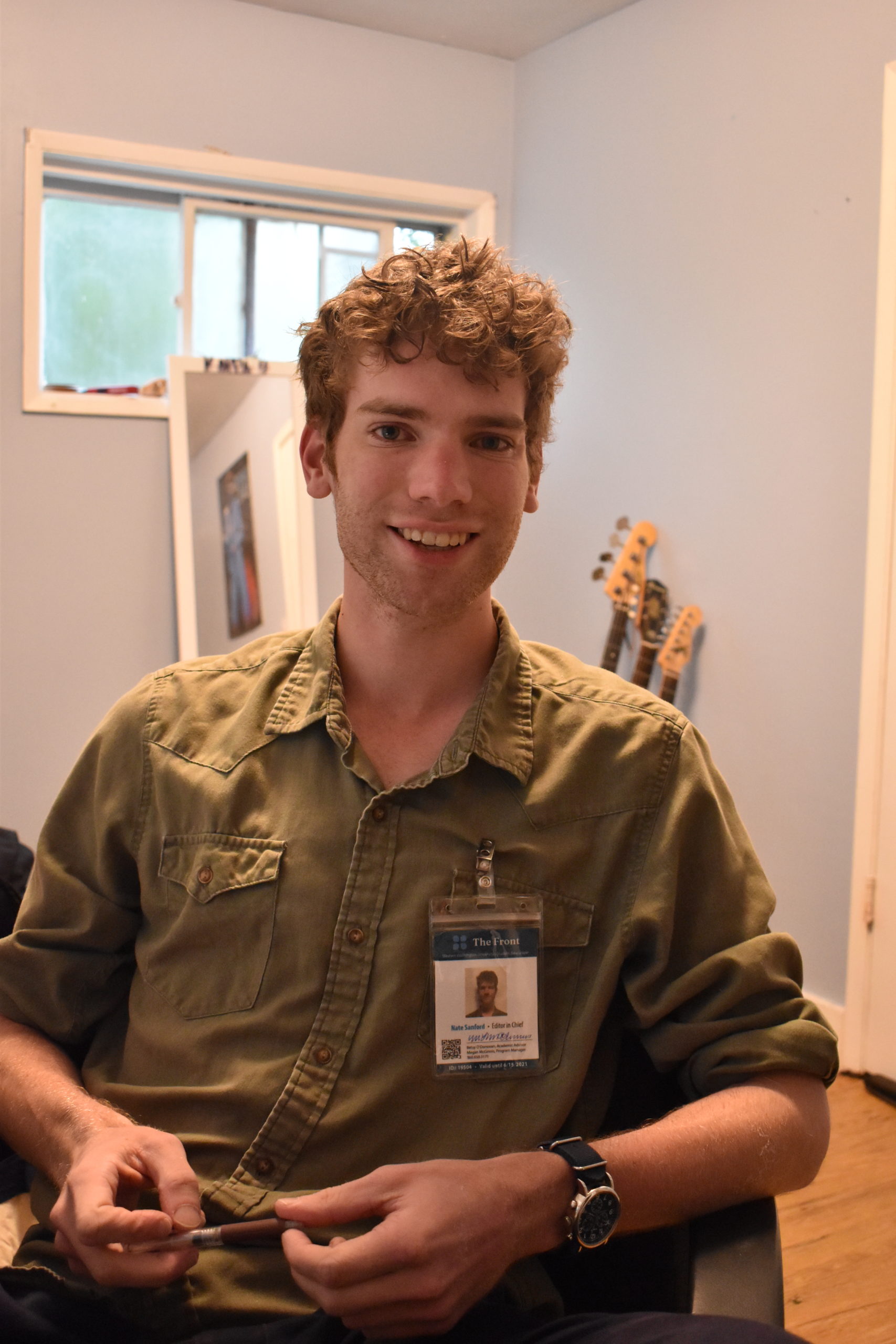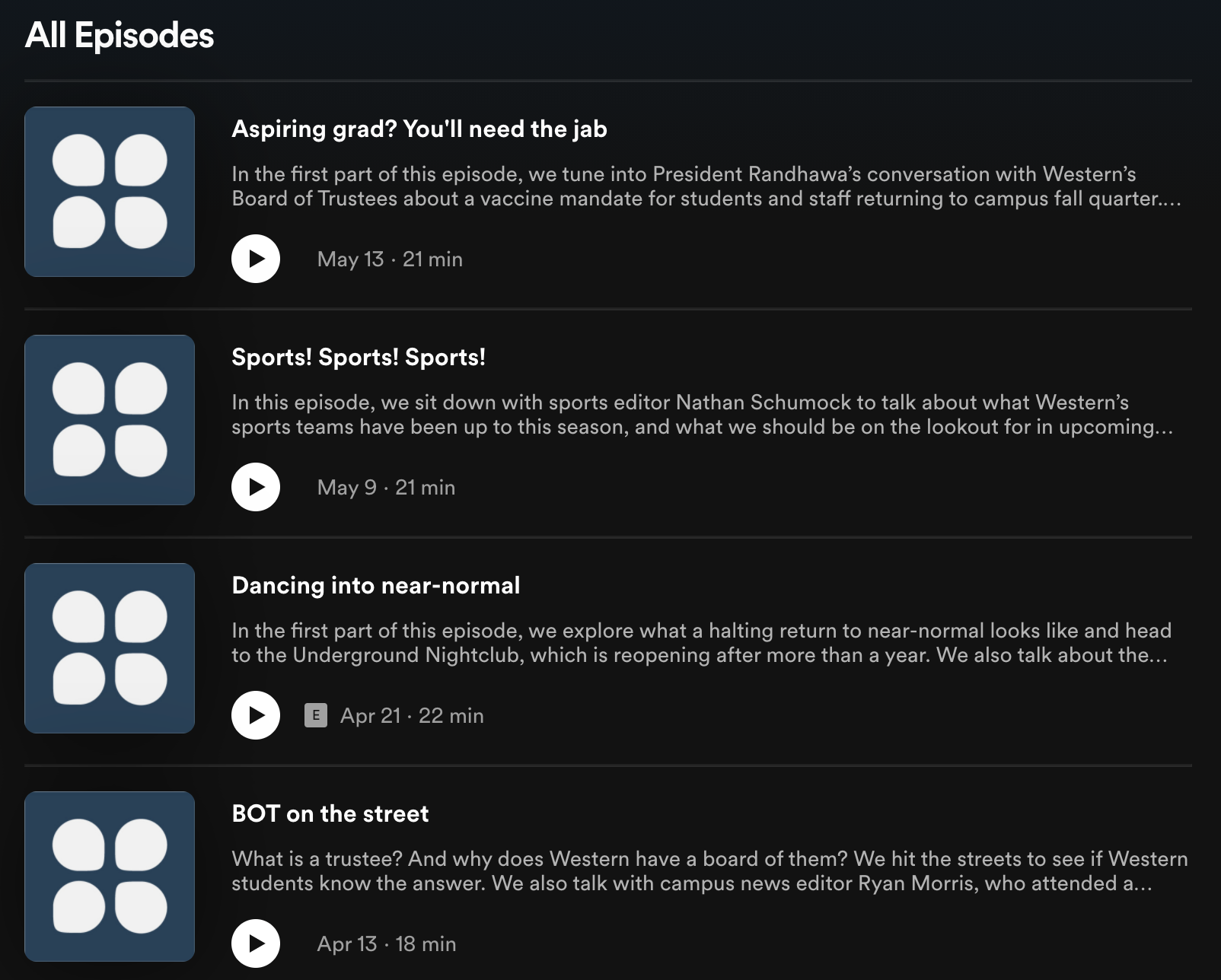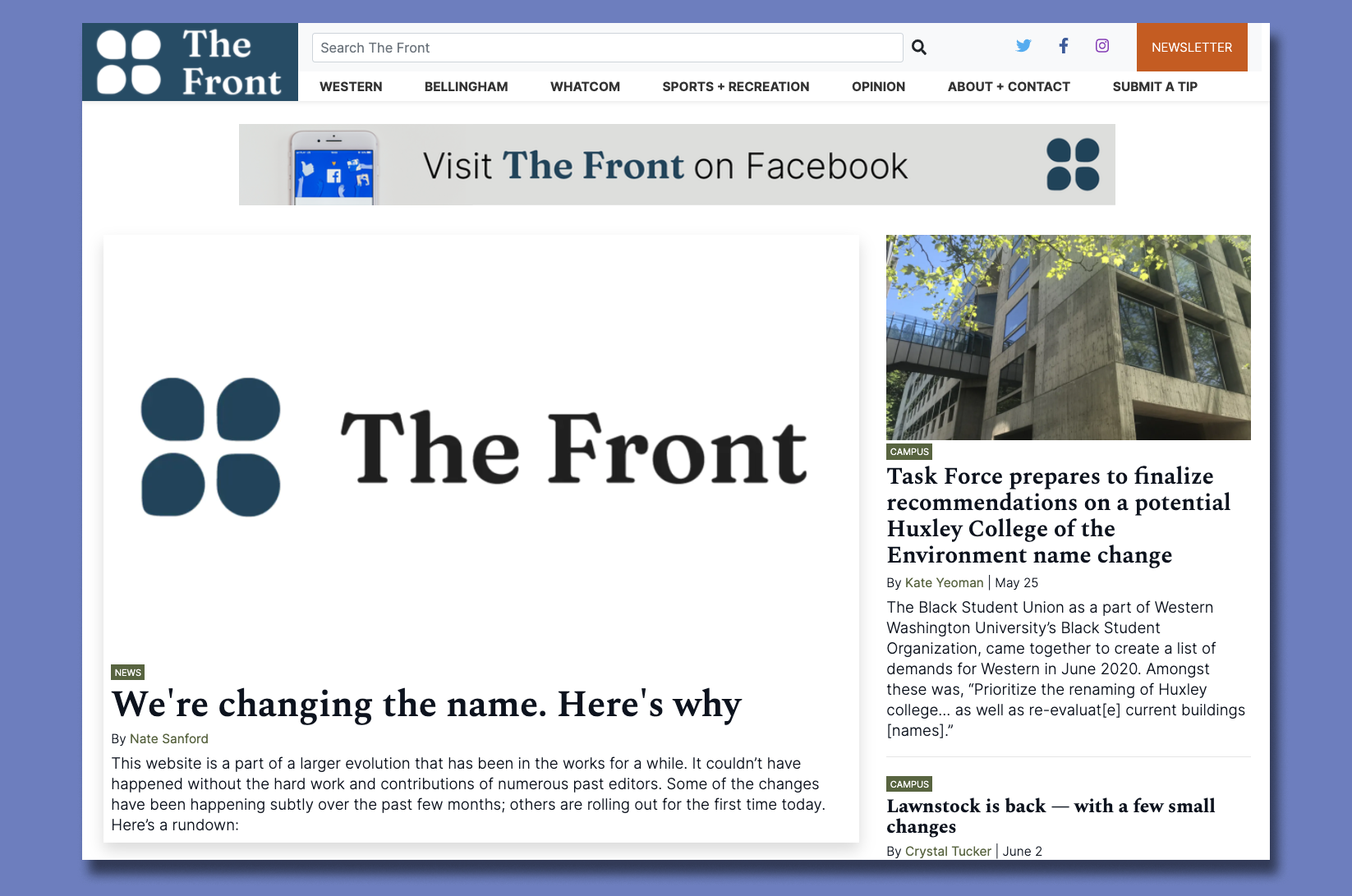Bearing a new name and logo, The Front launches updated website and weekly podcast
By Jaya Flanary
Following the infamous 2020, this year is full of new beginnings, including the rebranding of The Western Front. Before the newspaper became The Western Front in 1967, it was called the Straight News, the Collegian, The Normal Messenger and the Northwester Viking. Now, it is called The Front, and its staff is focusing on a digital-first presence.

Careful consideration of these changes was made by editors for years, but this quarter, The Front is launching an updated website and logo, new social media strategies and a new weekly podcast.
The name change is due to many factors, according to Nate Sanford, current editor-in-chief, including its reference to World War I. This makes search engine optimization for the publication difficult, and affects The Front’s hashtags, which are often muddled with unrelated content.
According to Sanford, many readers associate the name with the university, and assume that the paper is related to Western directly. However, The Front has full editorial independence, and Sanford hopes that the new name will help sources understand this separation. The Front also aims to cover stories outside of the university and its students.
“There is a real lack of local news, and even though we’re a student paper, we think that’s a hole we can try to help fill,” Sanford said. “Eventually, my hope is for us to become a serious community resource.”
This is apparent in The Front’s recent content, which includes a Tweet about alternatives to calling police and a story on House Bill 1090.
Because students haven’t been on campus during COVID-19, The Front stopped printing its regular weekly editions and has become a digital-only publication. Eventually, editors hope to print a few copies per quarter, but they will still focus on being digital-first.
“We really need to be stepping up with how we’re communicating and reaching audiences on social media and online in general,” Sanford said.

The effort to update the website began years ago when Asia Fields, who is now a reporter at The Seattle Times, was editor-in-chief. Since then, various editors, including Emily Feek and Izzie Lund, have contributed to making the rebranding happen. COVID-19, however, was the turning point.
“One of the things that happened as a result of the pandemic was a silver lining for us. It meant we were no longer distributing via print,” said Betsy O’Donovan, adviser for The Front. “Because we weren’t printing last year, we actually had some room in our budget to solve a long running problem with [the old website].”
The old website, which was built on WordPress by previous editors, became slow and outdated over time. In 2020, Editor-in-Chief Mysti Willmon made a request to the Student Publications Council to reallocate the print budget to updating the website. The Front chose SNworks from Michigan State University, which aims to create stable website platforms for student publications to design themselves. SNworks will regularly maintain backups, data transfers, plugins and more.
“Taking that off of students’ plates is going to mean that we can focus more on not just producing great journalism, but making sure that the journalism on the site is getting to more places because we have more time to push it out into the community,” O’Donovan said.
In order to broaden community outreach, The Front created new social media strategies including posting articles on directly related social media pages, as well as updating their tactics on Twitter and Instagram. Winter quarter’s social media editor, Ryan Morris, was especially interested in the social aspect of news. Morris worked in tandem with a student in J314, Sophia Pappalau.

The result is a robust social media presence in which The Front regularly posts on Twitter and Instagram, and creates a “constant churn of news” on the website, according to O’Donovan. They are also using tools to make journalism more interactive such as stories, polling, Q&A’s, and next quarter, TikTok. They were inspired by Axios and used Canva to make social media posts easily digestible for readers who like to skim news.
“What’s the headline? What’s the context that you need to know to understand this news? What is a key quote about it and where can you learn more?” O’Donovan said. “And then, if they get interested, they’ll do a deeper dive for a longer form piece.”
The team is noticing that people are reacting and responding a lot more to The Front’s coverage, which O’Donovan believes is because readers are feeling more informed.
“It’s created a much more informed conversation and a much more interesting one,” O’Donovan said. “We’re seeing a lot more people in the community reaching for The Front because we have expanded our news coverage.”
In addition to the updated website, The Front launched a new logo. Daniel McMorrow, a WWU design student, has been working with editors the last few years to create a new look. In winter quarter, editors decided they wanted the new logo to reflect our geographical location.
“We live in, if not a unique, certainly an unusually beautiful part of the country,” O’Donovan said. “The outdoors are so critical to people in Bellingham broadly and such an important asset for the community that they really wanted there to be an intense relationship between nature and The Front.”

McMorrow’s design looks like many things depending on how you look at it—raindrops, leaves, even a flower as a whole. The color scheme they chose reflects the colors we see in the Sehome Hill Arboretum during different seasons.
“We can turn aspects of the logo to draw attention to different things. We can drop photos into each of the different quadrants if we want to, to indicate seasonality or topicality. So it’s a really smart, clean logo design,” O’Donovan said.
In order to expand its digital presence, The Front also started a weekly podcast, The ForeFront, this quarter. The podcast is hosted by Sanford and his Managing Editor, Lauren Gallup, and produced by Nolan Baker, who holds the new editor position of Audio and Multimedia Producer.

Editors bring attention to the best and most important stories of the week in each podcast episode, by highlighting two or three stories in the first half and then expanding on a fourth story in the second half. Sanford hopes the podcast will be well-received by students because of the growing interest in podcast listening.
The ForeFront is a more useful and accessible way for readers to digest news, Sanford said. He hopes to get more student voices and bring additional sources in as the podcast develops.
The updates and changes are not instantaneous. They have been in the works for years, and The Front will continue to improve its coverage and digital presence. According to O’Donovan, however, The Front does not have the financial capacity to continue expanding and improving in every area they hope to, such as the podcast.
“Fundraising is something we’re going to have to start thinking about a lot in the next couple of years just because we want to be able to do more and we want to be able to step in where community journalism is sort of fading in Bellingham,” O’Donovan said.
Community journalism is something O’Donovan is an expert in—she has been studying the business model for community news for a decade. Community newsrooms are vulnerable because of small staffs and disruption to the ad-supported business model. This results in newspapers like The Bellingham Herald to reduce staff and move locations.
“What that means is there’s an opportunity for student newsrooms across the country to really step into a paraprofessional space where we are doing this civic service of providing robust, ethical journalism that is produced to high standards, that is not just occupied with student concerns, but that allows students to really, fully engage with the communities they’re in,” O’Donovan said.
As The Front expands and improves, O’Donovan hopes to see more journalism alumni get involved in teaching, inspiring and responding to these changes. She believes alumni feedback makes a profound difference for students.
“I would strongly encourage our alumni to respond to what students are doing. That’s the future of journalism,” O’Donovan said. “And if they get it right now, they’re going to be really great assets to your newsrooms later.”

